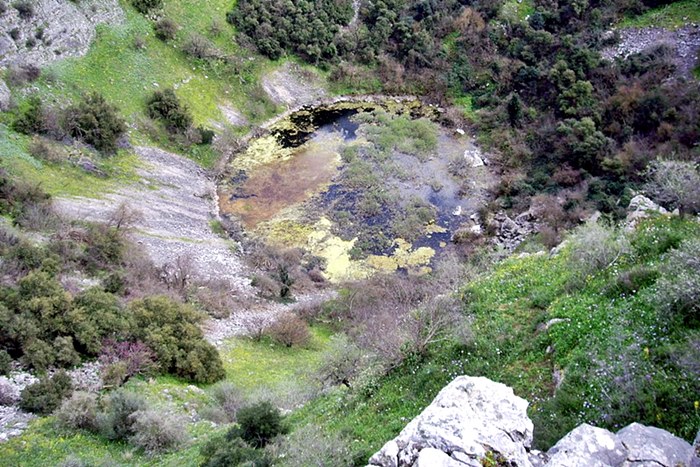The most impressive and perhaps the largest in Greece (width about 300 meters and depth about 270 meters) is the Dolini of Petroporos. A sinkhole is a geological phenomenon that was created thousands of years ago.
According to Léon Heuze, a French traveler, the area was called >Phtheos>, a name that he etymologically derives from the Greek word for bottom sin], but also Zurpapa [= mad priest] because of a tragic myth – legend.

The sinkhole and the legend of Zur papa
One of the most prevalent legends about the creation of the sinkhole, from where it got the name “Zourpapas”, is as follows:
A wedding once took place in the square. A priest was marrying one of his daughters, the most beautiful. But when he saw her dancing, he liked her so much that he started having immoral thoughts. Apparently drunk he approached her, grabbed her and kissed her. At that moment the earth opened and literally swallowed the city. Only the church remained intact at the edge of the theoretical hole.
According to another version of the legend, the following happened:
Gardiki was once an important city and a diocese. At the point where today the chasm opens, the public square was located. On a day of great feast the whole population had gathered there. The women danced, forming a large circle, according to local custom. A priest had an extremely beautiful daughter; he saw her at a ball and fell in love with her. He immediately goes to the bishop and tells him that he is coming to consult him about a matter that concerns him:
– A man has an apple tree in his garden that produces good apples, can he pick them himself by tasting the first, or must he leave the first to strangers?
The bishop replied that the man in question certainly had the right to eat his apples. Then the priest goes, takes his daughter from the dance, kidnaps her and satisfies his immoral desire. At the same time, the village square with the dancers and the whole town disappear with a sudden subsidence. Only the church remains standing at the edge of the opening of the abyss.”
The sinkhole and the scientific point of view
The Dolines that we find in the Greek mountain ranges, as in the others in other countries, are closed small basins – funnels, which were formed (and are still formed) in limestone rocks, when there are caves under them, which rest on springs or stagnant waters. These caves under the corroding power of water vapor and humidity – begin to “eat away” at their walls and ceiling, so we have precipitation of the entire cave and its disappearance in the depth of the water. These troughs are therefore sedimentary. In the Greek area, this geological phenomenon is common due to the limestone rocks, from which – mainly – the Greek mountain ranges are composed.



